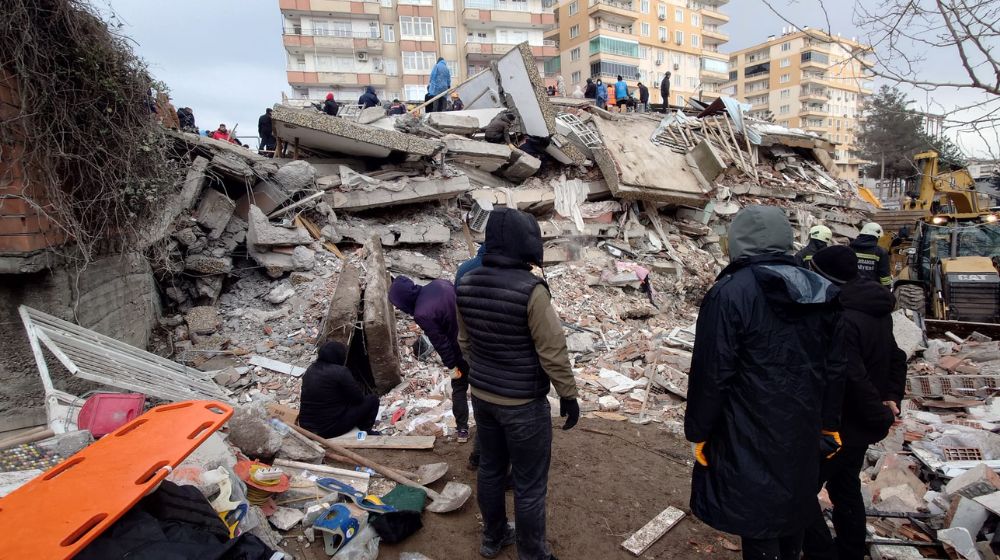Strong earthquakes struck Turkey and Syria on Monday. The region is frequently hit by tremors. Here’s why.
Thousands of people have died and many more were injured in the massive earthquakes that struck Turkey and Syria on Monday. The number of victims is expected to rise. Emergency workers are working around-the-clock to rescue people from the rubble, but they have to contend with adverse weather conditions. Temperatures in the affected areas frequently dip below freezing, and some affected areas have seen heavy snowfall.
The epicenter of the 7.4-magnitude quake was located in the province of Kahramanmaras near the Syrian border, according to Turkey’s Afad disaster management agency. Another 6.6-magnitude earthquake was measured shortly after in Gaziantep province, Afad said.
Dynamic puzzle
Earthquakes are not uncommon in Turkey and other regions of the world. But why? It’s important to know that the Earth’s crust is a kind of puzzle ― albeit a dynamic one that consists of many individual pieces: A few gigantic oceanic plates and several small continental crustal plates. The science is not conclusive on exactly how many.
Scientists know that these plates move a couple centimeters (approximately 1 inch) each year. They can move away from each other, toward each other or sometimes up against each other, causing the continent above them to move. These movements are called plate tectonics.
‘The question is not if an earthquake will occur, but when’
In October 2020, an earthquake shook the Aegean Sea. The epicenter was located off the province of Izmir near the surface of the sea. More than 100 people died and over 1,000 others were injured.
Turkey has long been of particular interest to earthquake researchers. The German Research Center for Geosciences (GFZ) in Potsdam installed measuring equipment in Turkey and has been conducting seismic monitoring in the country since the 1980s. GFZ records show that the earthquake risk is very high throughout the region around the Sea of Marmara, for example, where Istanbul lies.
“The question is not whether an earthquake will come. The question is when it will come,” Marco Bohnhoff, a seismologist at GFZ and an expert on the region, said in 2019.
Bohnhoff and other experts base this estimate on the occurrence of several strong earthquakes throughout Istanbul’s history, the ongoing continental drift beneath the Sea of Marmara and the existence of an area of the earthquake zone located just outside Istanbul that has long been suspiciously quiet.
Bohnhoff said that there was a lot of evidence suggesting that the plates in this area were “snagged,” causing tension to build up. Eventually, he suggested, the rock would not be able to withstand the tension anymore and the plates pushing against each other would move in a jolt of several meters in a matter of seconds.
Stable building structure and subsoil crucial for earthquake safety
The real danger to buildings, infrastructure and the local population is posed by the earthquake-waves in which the ground moves. How much damage they do depends on how strong the earthquake is.
A good way to keep people safe is earthquake-resistant construction. Unfortunately, this is very expensive, Bohnhoff said, adding that builders have to ask themselves whether to retrofit old buildings or tear them down and start from scratch.
During the quakes in the Turkish-Syrian border region on Monday morning, more than 1,700 buildings are said to have collapsed in Turkey alone.
“Photos shows that some of the collapsed buildings may have been built prior to modern seismic design code so they might not be appropriately designed and detailed for such a large magnitude earthquake,” said Mohammad Kashani, associate professor of structural and earthquake engineering at the University of Southampton in the UK.
“The combination of large magnitude and shallow depth made this earthquake extremely destructive. We need to investigate the collapsed structures in detail and learn from this devastating event to design our structures and cities to be resilient to such events.”
But it is not just a building’s bones that play a significant role in whether it can withstand an earthquake ― the ground on which it is built matters, too. As a general rule, the firmer the better, Bohnhoff said: “It is best if the subsoil is granite. Dry-laid sediments such as sand or clay are less preferable.”
On soft bedrock, he said, ground motion amplification is more likely to occur, sometimes along with what is called liquefaction. The seismologist compared this process to what happens with wet sand on a beach. If you repeatedly tap the same spot in the sand, water collects in the pit.
“Then the subsurface becomes unstable,” he said.


























